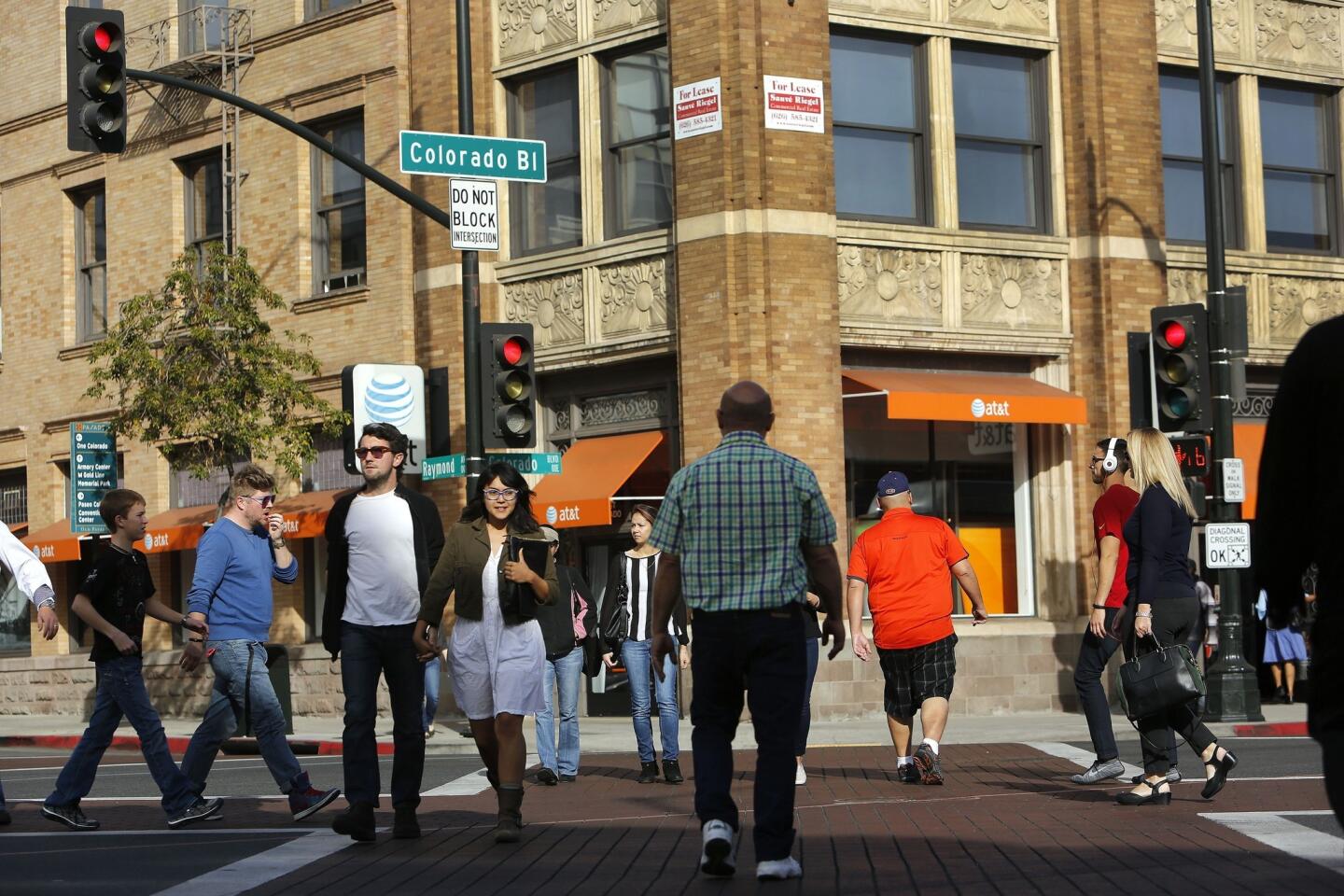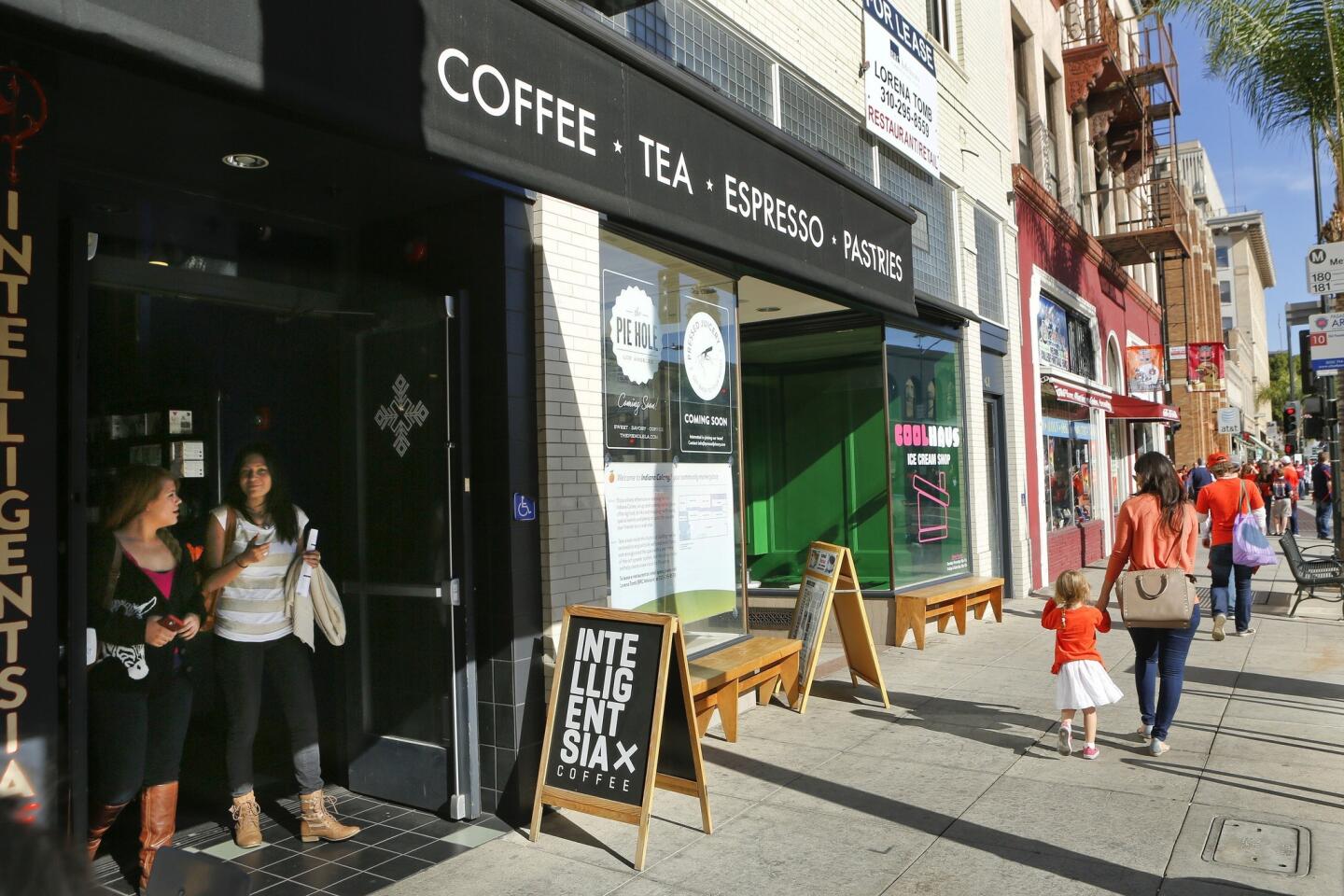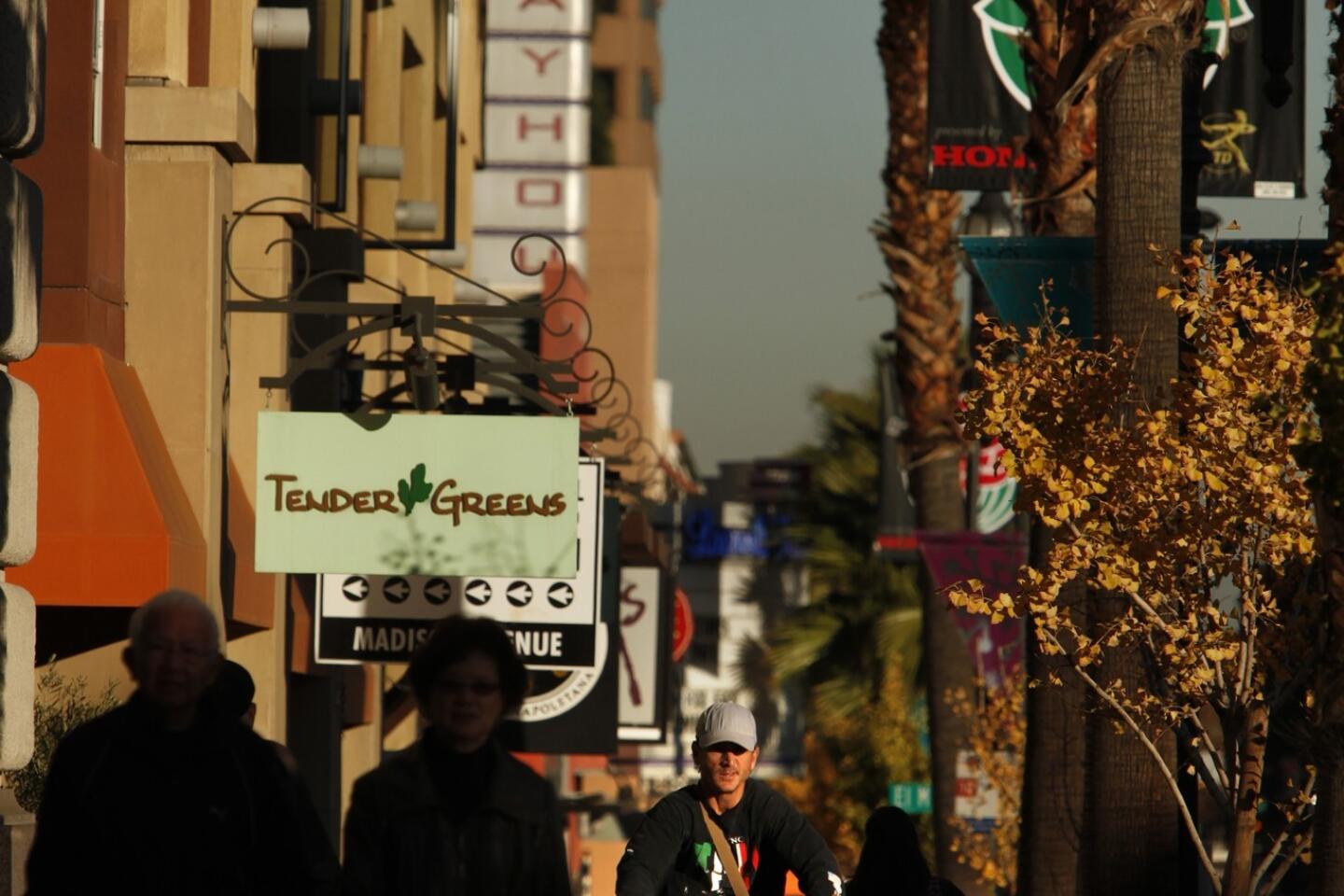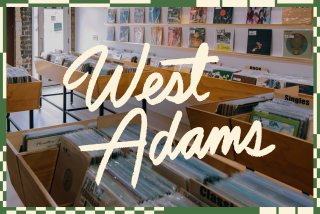Making Pasadena’s Colorado Boulevard a haven for pedestrians
From the very beginning, Colorado Boulevard was all about the car.
Pasadena residents so loved their Ford Model Ts that in 1915 the city was said to have the highest rate of automobile ownership in the world. Colorado was a leg in the famed Route 66 and evolved along with the car culture, with roadside businesses giving way to bigger department stores and eventually to shopping centers.
But these days, officials want to tame the famed street.
Pasadena is considering plans to narrow portions of Colorado by as much as two lanes and use that space to widen sidewalks and create tiny parks with seating and greenery. The proposal has generated wide support among some city leaders and is expected to go before the City Council soon.
To the west in Eagle Rock, officials have removed two lanes of traffic and used the space for three miles of bicycle lanes and new crosswalks and are discussing the addition of parklets, landscaped traffic medians and sidewalk extensions.
The effort to put Colorado on what some planners call a street “diet” reflects a transformation that began a decade ago. Once largely a retail strip, the boulevard, especially in Pasadena, has seen an influx of apartment and condominium complexes, with more than 1,000 residential units added along Colorado since 2003 and an additional 2,000 within three blocks.
And more is on the way, including several hotels. A 175-room hotel has been proposed for the site of the empty Macy’s at the Paseo Colorado and 500 hotel rooms on two sites previously used as a Ford dealership at Colorado and Hill Avenue. Also in the works is a $75-million to $100-million renovation of the 155-room, 1920s-era Constance Hotel at Colorado and Mentor Avenue.
City leaders say that with this development, Colorado needs to better balance the car and the pedestrian.
“Pasadena is pursuing a broader concept of what streets are about,” said Mayor Bill Bogaard. “They’re not simply for moving cars as fast as you can. Streets are corridors of society and community.”
Colorado is one of a growing number of busy boulevards across Southern California and the country that are being reevaluated as cities try to become more pedestrian and bike-friendly.
In downtown L.A., city officials put Spring Street on a road diet in 2011, taking away two lanes of traffic to create a bicycle-only route. Several weeks ago, they added buffered bike lanes through the 2nd Street tunnel, prompting concerns about more rush-hour traffic tie-ups for cars. In Long Beach, officials are considering a diet for Broadway.
For major thoroughfares like Colorado, this can be tricky because they carry so many cars (in Colorado’s case in Pasadena, about 20,000 a day).
Urban planners argue that widening sidewalks, beefing up mass transit and slowing down car traffic can actually boost business because it gets more shoppers walking streets. But the view in Pasadena is mixed, with some residents worried that narrowing Colorado will bring gridlock.
“I don’t think it’s a good idea,” said longtime resident Kim Moore, 50, who was walking along the boulevard with her husband on a recent afternoon to do some shopping. “If anything, they need to add a lane in each direction,” she said, because the street is already busy with traffic and it is difficult to find parking.
But some of Colorado’s newer residents like the idea. Greg Gunther and his wife moved into one of the newly built luxury apartments just off the boulevard a few years ago. They found themselves walking so much to local bookstores, shops and movie theaters that they recently got rid of one of their two cars.
Gunther recently received a letter from his auto insurance company, he said, asking him to prove how many miles he drove because it seemed too few for an urban area.
“It’s a wonderful change in lifestyle,” Gunther said of walking more. “I came to really value the way I relate to the physical space. When you’re in the car and you’re driving, you’re relating to the automobile and you’re in a cocoon. Now, all of a sudden, I’m much more aware of shops and the chance encounters I have with people. … You find yourself picking up trash on the street because you care.”
Nowhere is the chance to remake Colorado in Pasadena more pronounced than in the once-sleepy Playhouse District east of Old Pasadena.
Two decades ago, the district was dotted by empty storefronts, said Michael Moreno, who opened his Zona Rosa Caffe in 1993 near the intersection of Colorado and El Molino Avenue.
“It was totally empty when I moved in,” Moreno said. “At night, it was not safe. No one would come here. … Now, the vibe is totally different. There are places for people to go. They feel more secure.”
Beginning in the early 2000s, the area began seeing a development boom. Mid-rise apartment and condo complexes began replacing some of the retail buildings. The new residents brought new life to the district, and that has brought new businesses, officials said.
Erlinda Romo, executive director of the nonprofit Playhouse District Assn., said there has been a noticeable increase in pedestrians in the area. There are often lines of people, she said, outside the restaurants built in recent years along Colorado, including Tender Greens, Roy’s Hawaiian Fusion and Urth Caffe, which opened in August. There are proposals for a mixed-use building with a medical office, and three apartment complexes in the district will be under construction this year, she said.
“There’s a new vibrancy in the district,” Romo said. “There is increased foot traffic, and it brings energy to the street.”
Romo and others say the time is right to narrow the boulevard and add more public spaces for pedestrians, including small areas with seating and plants.
Current proposals the Playhouse District Assn. is discussing with city officials call for six to eight privately funded parklets to be built between Los Robles and Hudson avenues.
The parklets would provide small pockets of grass and trees along the boulevard, probably with seating for pedestrians. The parklets would be removable to accommodate the Rose Parade.
Under the plan, parking would be converted from parallel to angled, increasing the number of total spaces by about five per block, Romo said. The new streetscape would require reducing Colorado by one lane in each direction.
“Colorado’s role has changed over the years,” said Fred Dock, the city’s transportation director. “At
one point, it was a primary highway. As time has gone on, that traffic is now on the freeways, and Colorado is a local street … and there is the recognition that the street has different functions.”
More to Read
Sign up for Essential California
The most important California stories and recommendations in your inbox every morning.
You may occasionally receive promotional content from the Los Angeles Times.















